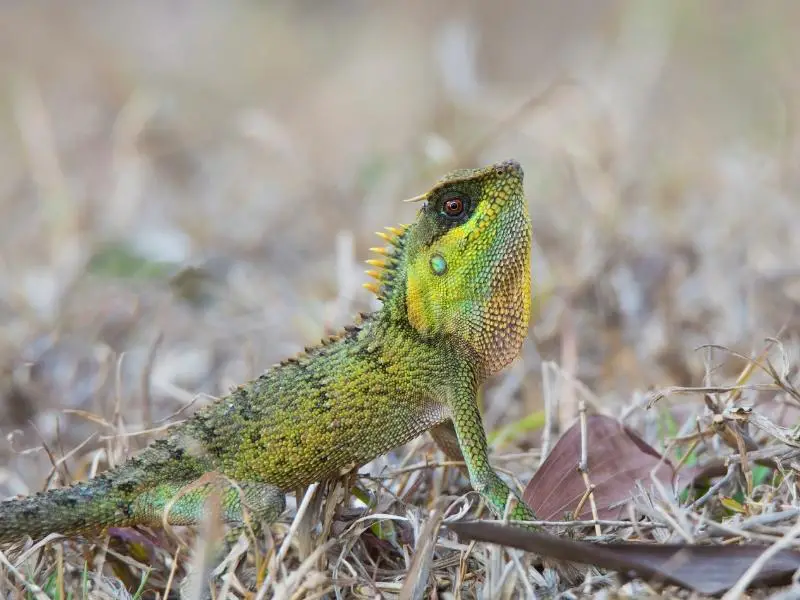
Description:
Scientific name: Acanthosaura capra
Life span: 8+ years
A species of agamid lizard called Acanthosaura capra is also referred to as the Indo-Chinese spiny lizard, the green pricklenape, and the mountain horned dragon. The Mountain Horned Dragon is a lizard of average size. They typically have a gray backdrop with orange or red patterns, while some are more yellow in color. The color of each individual animal changes. Large orange or red eyes, massive spines that are visible on the nape (back of the neck), and smaller spines that run along their back towards the tail are all characteristics of these animals.
Native Region/Habitat
These tree dwelling species are prevalent in humid forests and can be found in Burma, Thailand, the northern Malaysian Peninsula, Cambodia, and Southern Vietnam.

Behavior:
Owners of mountain horned lizards should be aware of certain habits that they exhibit. These are tranquil reptiles that can stand still for extended periods of time, a trait they employ when hunting insects in their natural environment. Mountain horned lizards have been known to remain motionless when faced with danger.
Care As a pet/In captivity:
The vivarium should be tall rather than long since the lizard is an arboreal one (living in trees). Provide a minimum of 1.5 to 2 feet in width, 3 feet in length, and 3 feet in height. Like with most reptiles, the happier the animal or animals will be the bigger the vivarium. Be cautious to estimate the size appropriately if you intend to retain more than one.
The compacted coconut bedding is the ideal substrate to use since it expands and traps moisture when water is applied. As Mountain Horned Dragons need humidity levels between 70 and 80 percent, this is a great way to maintain high humidity levels. Two daily mists can also aid in achieving the necessary levels. Fogger use is another effective technique. Put this on a timer so that it starts operating an hour before the lights come on and stops operating an hour before they go out. It creates a lovely impression inside the vivarium.
The ideal daily temperature for this species should be between 25 oC (78oF) and 27oC. (81oF). Offer spaces for sunbathing above the branches, but keep the vivarium’s temperature below 30oC (86oF). Allow for a 21-degree overnight temperature (70oF). Use a thermostat to assist regulate the temperature within the vivarium. Using a UV lamp is crucial because it enables your Mountain Horned Dragon to manufacture the necessary amounts of vitamin D3. Despite the fact that these creatures live in forests, we advise using a 5% UV light.
If necessary, water should be available in a big water dish or container so they can have a soak. They cannot detect stagnant water, thus it is crucial that it is moving. You can accomplish this by creating a miniature waterfall inside the main water container, or you can use an air stone connected to a pump for a better effect. With these lizards, dehydration is a major problem, but if you follow these instructions, there shouldn’t be any issues.
Since these lizards are insectivores, you should give them insects like small spiders, locusts, mealworms, and wax worms. Mountain Horned Dragons adore earthworms! If you can’t find them in your garden, you can buy them from bait shops for a very low price and they are highly high in calcium and nutrients. To keep the worms actively seeking out live things, you can provide them with a few crickets or locusts every day, but you must be careful not to overfeed them.
Table





